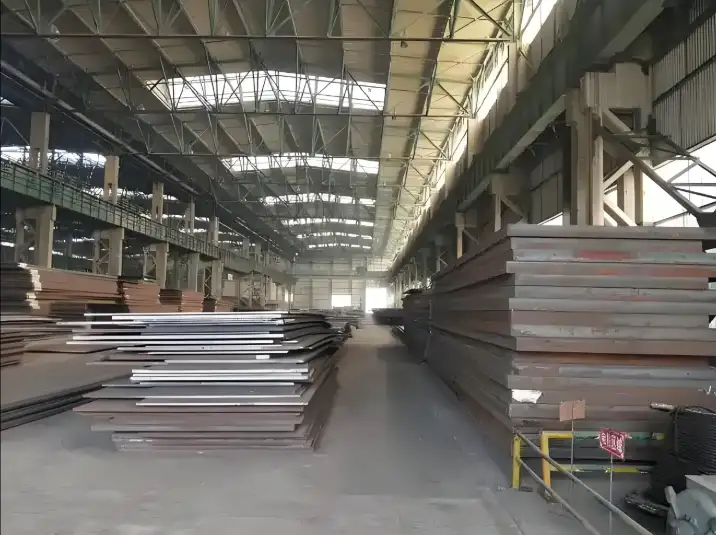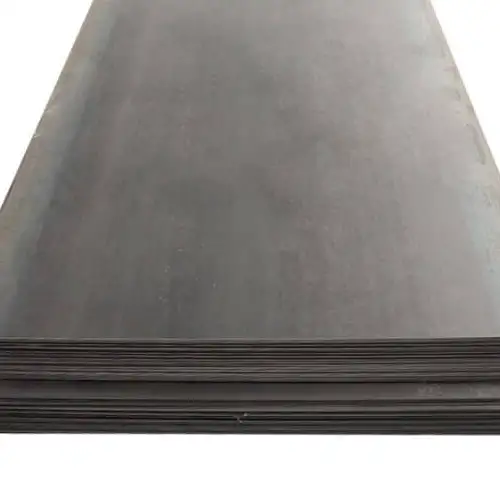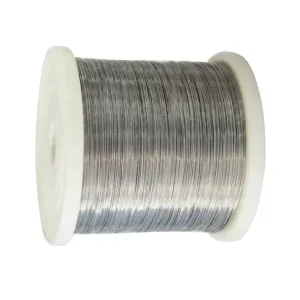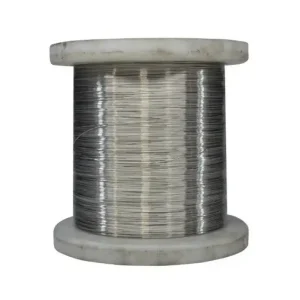ASTM A572 Steel Plates are high-strength low-alloy (HSLA) steels that provide an excellent combination of strength, toughness, and durability. Designed for a wide range of structural applications, these steel plates are available in Grades 42, 50, 55, 60, and 65. Whether used in construction, machinery, or engineering, ASTM A572 steel plates are recognized for their ability to withstand heavy loads, corrosion, and impact, making them ideal for use in various industries including construction, transportation, and infrastructure development. At MWalloys, we offer premium-quality ASTM A572 steel plates, ensuring that each product meets international standards and specifications.
What is ASTM A572 Steel Plates
ASTM A572 is a specification developed by ASTM International for high-strength, low-alloy steel plates. This steel is designed to be used in structural applications where high strength-to-weight ratios are essential. The steel plates are produced in five different grades, each offering varying levels of yield strength and durability. The plates are ideal for use in demanding applications such as bridges, buildings, and other heavy-duty structures.
Key Features and Benefits
-
High Strength: Each grade of ASTM A572 steel plate offers impressive yield and tensile strength, making it suitable for structural applications.
-
Enhanced Durability: Resistant to impact and corrosion, ASTM A572 plates maintain their performance under harsh environmental conditions.
-
Versatility: Available in a range of grades, ASTM A572 plates offer flexibility to meet specific project requirements.
-
Cost-Effectiveness: Due to their strength, these plates allow for reduced material usage in many applications, resulting in lower overall project costs.
Grades of ASTM A572 Steel Plates
The ASTM A572 specification covers the following grades:
-
Grade 42: Minimum yield strength of 42,000 psi (290 MPa).
-
Grade 50: Minimum yield strength of 50,000 psi (345 MPa).
-
Grade 55: Minimum yield strength of 55,000 psi (379 MPa).
-
Grade 60: Minimum yield strength of 60,000 psi (414 MPa).
-
Grade 65: Minimum yield strength of 65,000 psi (448 MPa).
Each grade is designed for specific applications, with higher grades offering enhanced strength for more demanding environments.
Standard Overview & Grade Definitions
*(ASTM A572/A572M-2024)*
| Parameter | Specification | Key Notes |
|---|---|---|
| Scope | High-strength low-alloy (HSLA) structural steel plates with niobium-vanadium microalloying for bridges, buildings, and machinery | Excludes pipes, bars, or tubes |
| Conflict Priority | 1. Purchase Order > 2. Product Spec > 3. ASTM A572 | Mandatory tests cannot be waived |
| Unit Systems | • Imperial (A572): inch-lb • Metric (A572M): SI units • ⚠️ Mixing units voids compliance |
Metric grades use "Gr" suffix (e.g., A572MGr50) |
| Key Alloy Elements | Nb (Niobium), V (Vanadium) — enhances strength & weldability | Nb restricted to ≤20mm thickness for Gr60/65 |
Chemical Composition Comparison
(Weight %, Melt Analysis)
| Element | Gr42 | Gr50 | Gr55 | Gr60 | Gr65 | Permissible Variation |
|---|---|---|---|---|---|---|
| C (Carbon) | ≤0.21 | ≤0.23 | ≤0.25 | ≤0.26 | 0.23–0.26 | ±0.01% |
| Mn (Manganese) | ≤1.35 | ≤1.35 | ≤1.35 | ≤1.35 | 1.35–1.65 | ±0.05% |
| P (Phosphorus) | ≤0.04 | ≤0.04 | ≤0.04 | ≤0.04 | ≤0.04 | ±0.005% |
| S (Sulfur) | ≤0.05 | ≤0.05 | ≤0.05 | ≤0.05 | ≤0.05 | ±0.005% |
| Si (Silicon) | ≤0.40* | ≤0.40* | ≤0.40* | ≤0.40* | ≤0.40* | ±0.03% |
| Nb+V (Niobium + Vanadium) | 0.01–0.15 | 0.01–0.15 | 0.01–0.15 | 0.01–0.15 | 0.01–0.15 | Reported in MTRs |
*Si range: 0.15–0.40% for thickness >40mm.
Mechanical Properties Comparison
*(Hot-rolled condition, thickness ≤200mm)*
| Property | Gr42 | Gr50 | Gr55 | Gr60 | Gr65 | Test Standard |
|---|---|---|---|---|---|---|
| Yield Strength (min) | 290 MPa (42 ksi) | 345 MPa (50 ksi) | 380 MPa (55 ksi) | 415 MPa (60 ksi) | 450 MPa (65 ksi) | ASTM E8/E8M |
| Tensile Strength | 415 MPa (60 ksi) | 450 MPa (65 ksi) | 485 MPa (70 ksi) | 520 MPa (75 ksi) | 550 MPa (80 ksi) | ASTM E8/E8M |
| Elongation (min): | ||||||
| - 200mm gauge length | 20% | 18% | 17% | 16% | 15% | |
| - 50mm gauge length | 24% | 21% | 20% | 18% | 17% | |
| Hardness (Typical) | 140–180 BHN | 150–190 BHN | 160–200 BHN | 170–210 BHN | 180–220 BHN | ASTM E10 |
💡 Thickness Impact: For Gr60/65 plates >32mm thick, yield strength drops by 10–15 MPa.
Dimensional Tolerances
*(Per ASTM A6/A6M-2024)*
| Parameter | Tolerance (Thickness ≤6mm) | Tolerance (Thickness >6mm) | Critical Notes |
|---|---|---|---|
| Thickness | ±0.15 mm (±0.006") | ±10% of nominal thickness | Precision tolerances available via PO |
| Width | ±3 mm (±0.12") | ±5 mm (±0.2") | |
| Length | ±10 mm (±0.4") | ±15 mm (±0.6") | |
| Flatness | ≤5 mm/m | ≤3 mm/m | Mill finish only |
Common Sizes & Theoretical Weight Tables
Plate Dimensions (Hot-Rolled, Standard Mill Stock)
| Thickness | Width Range | Length Range | Weight (kg/m²) | Weight (lb/ft²) |
|---|---|---|---|---|
| 6 mm (0.24") | 1500–4000 mm | 6000–12000 mm | 47.1 | 9.65 |
| 12 mm (0.47") | 2000–4000 mm | 6000–12000 mm | 94.2 | 19.3 |
| 25 mm (1") | 2000–3900 mm | 6000–14000 mm | 196.3 | 40.2 |
| 40 mm (1.57") | 1600–3500 mm | 6000–12000 mm | 314.0 | 64.3 |
| 50 mm (2") | 1250–3000 mm | 6000–10000 mm | 392.5 | 80.4 |
Weight Calculation Formula
-
Metric:
Weight (kg) = Length (m) × Width (m) × Thickness (mm) × 7.85 -
Imperial:
Weight (lb) = Length (ft) × Width (ft) × Thickness (in) × 9.7
Example: 10ft × 4ft × 0.5" Gr50 plate = 10 × 4 × 0.5 × 9.7 ≈ 194 lbs.
Grade-Specific Applications & Processing
| Grade | Typical Uses | Welding | Corrosion Protection |
|---|---|---|---|
| Gr42 | Light structures, non-critical frames | No preheat (<20mm), SMAW/GMAW | Paint or galvanizing (optional) |
| Gr50 | Cranes, trailers, road plates | Preheat ≥50°C (>25mm thickness) | Hot-dip galvanizing (ASTM A123) |
| Gr55 | Mining equipment, truck chassis | Preheat mandatory (>20mm) | Epoxy coating + polyurethane topcoat |
| Gr60 | Bridges, seismic structures | Low-H electrodes, post-weld heat treatment | Metallizing (zinc/aluminum spray) |
| Gr65 | High-stress bridge components | Controlled interpass temperature | Industrial-grade epoxy systems |
-
Impact Toughness: Gr60/65 require -30°C Charpy V-notch testing for cryogenic applications.
-
Dimensional Flexibility: Custom widths up to 4,000mm and lengths up to 14,000mm available.
-
Traceability: Mill Test Reports (MTRs) must include Nb/V content and heat treatment records.
-
Equivalents:
-
EN: S355JR (Gr50)
-
JIS: SM490A (Gr60)
-
GB: Q345B (Gr50)
-
-
Cutting Tolerance: Laser/plasma cutting allowance: +3mm per edge.

Applications of ASTM A572 Steel Plates
ASTM A572 steel plates are commonly used in:
-
Construction: Bridges, buildings, and other structural projects requiring high-strength materials.
-
Heavy Machinery: For manufacturing components like chassis, gears, and cranes.
-
Transportation: Used in the fabrication of railcars and other transport equipment.
Comparison with Other Steel Grades
While ASTM A572 is a high-strength steel, it is often compared to other alloy steels like ASTM A36 or A992. However, A572 offers superior strength at lighter weights, which is particularly beneficial for large-scale structural applications.
| Steel Grade | Yield Strength | Typical Applications |
|---|---|---|
| ASTM A36 | 36,000 psi | General construction, bridges |
| ASTM A572-50 | 50,000 psi | Structural beams, bridges, cranes |
| ASTM A992 | 50,000 psi | Steel structures and beams |
Global Pricing Trends and Market Insights 2025
The pricing of ASTM A572 steel plates fluctuates based on market conditions, including raw material costs, demand, and production capacities. Currently, prices are influenced by factors like the global demand for infrastructure development and the availability of steel scrap.
| Region | Price (per ton) |
|---|---|
| USA | $700–$900 |
| China | $650–$850 |
| Europe | $750–$950 |
| India | $600–$800 |
Frequently Asked Questions (FAQs)
-
What are the different grades of ASTM A572 steel plates, and how do they differ?
ASTM A572 steel plates come in five grades: 42, 50, 55, 60, and 65. Each grade offers different yield strengths, with Grade 42 being the lowest and Grade 65 offering the highest. The higher the grade, the more strength and durability the steel provides, making it suitable for more demanding applications.
-
Can ASTM A572 steel plates be welded?
Yes, ASTM A572 steel plates are weldable. However, for higher-strength grades, preheating and post-weld heat treatment are recommended to avoid cracking and ensure optimal weld integrity.
-
What industries use ASTM A572 steel plates?
ASTM A572 steel plates are widely used in construction, heavy machinery, and transportation. These include applications such as bridges, building structures, cranes, railcars, and industrial machinery, where strength and durability are paramount.
-
How do the mechanical properties of ASTM A572 steel plates compare to other structural steel grades like A36 or A992?
While ASTM A36 offers a yield strength of 36,000 psi, ASTM A572 provides higher yield strengths—Grade 50 offers 50,000 psi, and Grade 65 offers 65,000 psi. This makes ASTM A572 a superior choice for projects requiring higher strength-to-weight ratios, reducing material usage while maintaining structural integrity.
-
What is the recommended application for ASTM A572 Grade 65 steel plates?
ASTM A572 Grade 65, with a yield strength of 65,000 psi, is ideal for high-stress applications such as bridges, offshore platforms, and heavy machinery that require exceptional durability and impact resistance.
-
What is the corrosion resistance of ASTM A572 steel plates?
ASTM A572 steel plates offer moderate corrosion resistance under standard conditions. However, for environments with high humidity or corrosive elements, additional coatings such as galvanizing or painting can enhance the corrosion resistance of the plates.
-
Are ASTM A572 steel plates cost-effective compared to other steel grades?
Yes, ASTM A572 steel plates are considered cost-effective because they offer superior strength and durability, reducing the need for thicker plates or additional materials. This results in reduced overall project costs, especially in large-scale applications.
-
What are the key factors influencing the pricing of ASTM A572 steel plates?
The pricing of ASTM A572 steel plates is influenced by factors such as global steel demand, raw material costs, production capacities, and regional market conditions. Prices typically fluctuate depending on economic cycles, trade policies, and infrastructure development trends.
-
What are the benefits of using ASTM A572 steel plates in structural engineering?
The benefits include high strength, excellent weldability, and outstanding impact resistance. These plates allow for lightweight, durable, and cost-effective designs in structural applications, ensuring long-lasting performance under heavy loads.
-
How can I ensure the quality of ASTM A572 steel plates?
To ensure quality, it is essential to source ASTM A572 steel plates from reputable suppliers, like MWalloys, who adhere to strict manufacturing standards. Certifications such as ASTM compliance and ISO certifications are good indicators of product quality.
Why Choose MWalloys for ASTM A572 Steel Plates?
At MWalloys, we pride ourselves on providing high-quality ASTM A572 steel plates that meet international standards. With our commitment to excellence and customer satisfaction, we ensure each plate is meticulously tested for strength, durability, and performance.





